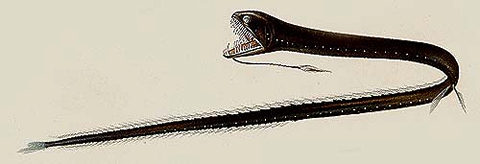Black Dragonfish (Idiacanthus atlanticus) female Black Dragonfish
Idiacanthus atlanticus Brauer, 1906
[Photo] Female Black Dragonfish from Brauer, 1906. (Reference: Brauer, A. 1906. Die Tiefsee-Fische. I. Systematischer Teil. In: C. Chun. Wissenschaftl. Ergebnisse der deutschen Tiefsee-Expedition "Valdivia," 1898-99. Jena. v. 15: 1-432, Pls. 1-18.)
The Black Dragonfishes (Family Idiacanthidae) are long, slender fishes which live in mesopelagic to bathypelagic waters down to depths of about 2000 m.
These fishes are sexually dimorphic. The top two images show a female with its small eyes, chin barbel, and long fang-like teeth, which are used for catching its primary food item - other fishes. The male is much smaller (5 cm maximum length vs 40 cm for the female). It lacks teeth, lacks the chin barbel, has a non-functional gut, and is dark brown rather than black.
Like many deepsea fishes, the Black Dragonfish can produce its own light. This species has tiny photophores scattered over its body and two rows of larger photophores along the side of the body. The chin barbel of the female has a a slender luminous tip. This may be used to attract prey.
Larval Black Dragonfishes are most unusual. They are long, slender, transparent fishes that have their eyes at the ends of long stalks which can be up to half the length of the body.
The Family Idiacanthidae contains three species, two of which, Idiacanthus fasciola Peters, 1877 and Idiacanthus atlanticus occur in Australian waters. The 22 cm long specimen in the images above was sent to the Australian Museum by the Fisheries Inspectors at Eden, New South Wales. It is now registered in the Fish Collection as AMS I.39054-001.
Text Source: http://www.amonline.net.au/fishes/fishfacts/fish/iatlan.htm
